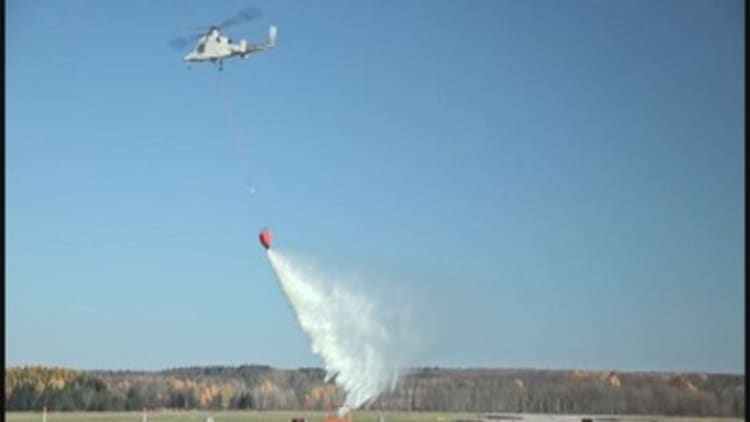
Necessity is the mother of invention. That may be one reason you could see the nation's largest defense contractor teaming up with your local fire department.
Lockheed Martin has been demonstrating the capabilities of its unmanned helicopter, the K-MAX, as a firefighting tool. Two of the drone choppers were used in Afghanistan to deliver supplies to Marines "day or night to precise locations without risk of losing life in the process."
Now that U.S. combat operations in Afghanistan are ending, Lockheed and partner Kaman Aerospace are looking for new commercial markets for the K-MAX, which can fly higher and carry heavier cargo loads than similar drones. In video released by the company, the K-MAX dropped fire retardant to put out flames during a test. The helicopter worked with a second, 4 pound drone called the Indago, which flies ahead as a fire scout. Lockheed said the K-MAX lifted and dropped more than 12 tons of water on target in one hour. The unmanned aircraft also demonstrated the ability to deliver vehicles and cargo.
In a statement, Lockheed's Dan Spoor said, "The unmanned K-MAX and Indago aircraft can work to fight fires day and night, in all weather, reaching dangerous areas without risking a life."
Creating new uses for military products is important as defense companies face uncertainty about future weapons programs. For example, Reuters reports that Israel may cut in half its next order of Lockheed's important F-35 jet fighter. Many defense companies are moving into areas with commercial applications like cybersecurity. Northrop Grumman on Wednesday announced the launch of an Advanced Cyber Technology Center to provide "affordable solutions to the most complex customer needs." Not everything is panning out, however. Boeing is reportedly considering downsizing its cyber business as "the market has not proven to be as promising as once expected."
Read More
Adapting existing products to new uses takes time and money, and the K-MAX is ramping up slowly. Two of the aircraft are available now, according to the company, with two more coming on line by the middle of next year. Lockheed is pitching the drone to contractors for the U.S. Forest Service and the Interior Department. The FAA has yet to approve the general use of unmanned aircraft in domestic airspace, but firefighting can be an exception as certain restrictions kick in..
"The FAA would designate the airspace in the vicinity of the fire area as restricted airspace," said Lockheed spokesman Keith Little. "We would coordinate with the FAA prior to any actual usage regarding obtaining COA (Certificates of Waiver or Authorization) approval for K-MAX that would allow a quick approval for use of K-MAX in support of firefighting operations in the designated restricted area."
Read More
Lockheed Martin is also pitching the K-MAX for offshore drilling and humanitarian operations. As for cost, Little said the K-MAX operated in Afghanistan for $1,300 an hour, much lower than the cost of manned firefighting helicopters in the U.S. One report by the state of Washington said Western states were paying as much as $6,696 an hour for helicopters during wildfires in 2010.
Meantime, the U.S. government still owns two K-MAX helicopters, and there remain potential uses for equipment taxpayers already paid for. Defense One reporter Michael Auerbach recently asked, "Why isn't the Pentagon using supply drones for Ebola?" He pointed out that many nondefense companies are working on delivery drones--most notably Amazon—"but the technology that is currently available to civilians is insufficient for the urgent challenge in West Africa." Auerbach said the only drones capable of such a mission right now are the K-MAX and the Ares by Shield Aviation. "These are extraordinary machines."
A Defense Department official tells CNBC the K-MAX has not been used in West Africa as it has not been needed to complete the military's mission there. U.S. forces are acting in support of the lead agency, USAID, to provide command and control, construct Ebola treatment centers, do training, and run mobile testing labs. The official said the K-MAX was not seen as the best tool available to complete that mission, but if USAID asked for more or different help in the future, "We are committed to helping."
A Defense Department official told CNBC the K-MAX has not been used in West Africa, as it has not been needed to complete the military's mission there. U.S. forces are acting in support of the lead agency, USAID, to provide command and control, construct Ebola treatment centers, do training and run mobile testing labs. The official said the K-MAX was not seen as the best tool available to complete that mission, but if USAID asked for more or different help in the future, "We are committed to helping."


